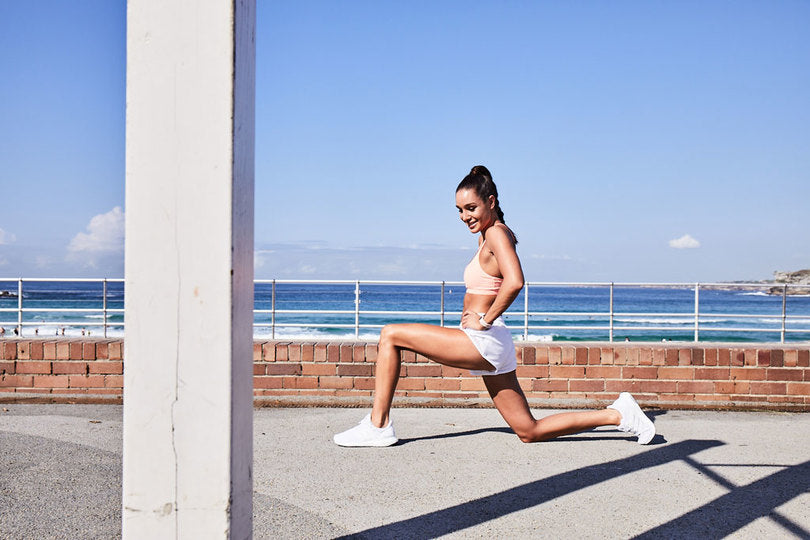Foam Roller Exercises


By now I am sure that most of you have seen me talking about foam rolling.
For me, a foam roller is an essential piece of equipment I can’t live without. I foam roll after every workout to help increase blood flow and to make it easier for my body to recover.
Jump to:
- What is foam rolling?
- Why use a foam roller?
- How to use a foam roller
- Foam roller exercises
- Calf exercises
- Back exercises
- My foam rolling tips
If you’re not sure what foam rolling actually is or why it can be beneficial, I have some tips to help you learn more, plus some foam roller exercises to help you with your recovery!
What is foam rolling?
Foam rolling is also known as self-myofascial release (SMR), a form of self-massage that can help to release muscle tightness.
A foam roller allows you to apply pressure to muscle groups that may have developed tight spots due to overuse, poor posture and strain. When you have trigger points or tension in your muscles, it can make it hard for them to perform to their full capability.
Why use a foam roller?
Foam rolling can help release these tension points, allowing you to move more freely, increasing blood flow to your muscles and helping your body to recover faster.
Another benefit of foam rolling is it gives you control over the pressure you apply to those tight spots. If you’ve ever had a deep tissue massage, you’ll know that it can be quite uncomfortable (sometimes even painful) having those tight spots worked on. Using a foam roller regularly can help keep the blood flowing and reduce the amount of tension building in your muscles.

How to use a foam roller
Starting with the muscle group you want to focus on, position it on the foam roller. You may need to reposition your body so you are placing pressure on the muscle. As you slowly roll along the muscle, you may reach a point of tenderness — this is called a trigger point.
When you reach this point of tenderness, try to pause and hold pressure on the spot for 60-90 seconds. This can help to increase the length of the myofascial fibres and increase blood flow to the area, allowing your muscle and fascia to move without being restricted.
Foam roller exercises
Here are a few exercises you can use to target specific muscle groups.
Foam roller exercise for your calves
Foam rolling the calves can help to reduce tension around your calves, ankles and knees. Tight calves can reduce mobility in your lower leg, so regular foam rolling is great for minimising stiffness.
- Position the foam roller horizontally in front you. Extend both legs and place on top of the roller, crossing your left ankle over your right.
- Allow the foam roller to press into the lowest part of your right calf muscle (about 10 cm above your ankle). This may require you to lift your body off the floor.
- Slowly roll the foam roller along the length of your calf. Once you reach a point of tenderness, pause and hold that position for up to 60 seconds or until the pressure/pain is significantly reduced. You can choose to perform small strokes over the point of tenderness if you would prefer.

Foam roller exercise for your back
If you’re feeling tension in your upper back, foam rolling your trapezius (the muscle to the sides of your spine) can help. As an added bonus, it can help to improve your posture too — especially after sitting all day.
- Position the foam roller horizontally behind you. Bend your knees and position your feet firmly on the floor. Lay back onto the foam roller so that your upper back is resting on the roller.
- Twist your upper body slightly to the right so that the foam roller is pressing into your right trapezius. This may require you to lift your hips slightly off the floor.
- Slowly roll the foam roller along the length of your trapezius. Once you reach the point of tenderness, pause and hold that position for up to 60 seconds or until the pressure/pain is significantly reduced. You can choose to perform small strokes over the point of tenderness if you would prefer.
- Continue to roll down the length of your trap until you reach the bottom of your shoulder blade, pausing on trigger points as needed. Do not foam roll your lower back.
There are some areas of your body that you should avoid foam rolling. The neck, head and abdomen all protect major organs and nerves and blood vessels are positioned quite close to the skin in these spots. Foam rolling the neck and lower back should be avoided — see your health care professional if you are noticing some discomfort in these areas.
My tips for foam rolling
Don’t roll too quickly! Go slowly and hold the pressure on each muscle for 30-60 seconds (if you can manage it).
I spend about 10-15 minutes foam rolling after every training session. I like to set a timer and then roll out my whole body, focusing on the really sore spots. It might feel a little uncomfortable at the time but I always feel better afterwards!
Grab your foam roller and start!
Adding some foam roller exercises to your post-workout routine can make a huge difference to your recovery. Not only that but foam rolling can also reduce the appearance of cellulite because it helps increase blood flow and the removal of toxins.
I’ve found that regular foam rolling helps me to sleep better, recover faster and keep up with my training, so I make sure to do it regularly.
Do you ladies use a foam roller? Do you find it helps? Let me know in the comments.
* Disclaimer: This blog post is not intended to replace the advice of a medical professional. The above information should not be used to diagnose, treat, or prevent any disease or medical condition. Please consult your doctor before making any changes to your diet, sleep methods, daily activity, or fitness routine. Sweat assumes no responsibility for any personal injury or damage sustained by any recommendations, opinions, or advice given in this article.







<#= c.user.username #><#= moment(c.created_at * 1000).fromNow() #>
<#= c.html_body #> <# if (c.images) { #>
<# } #>